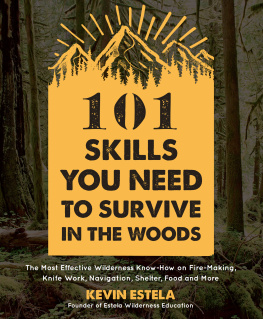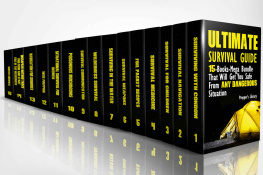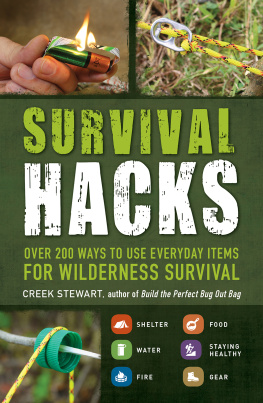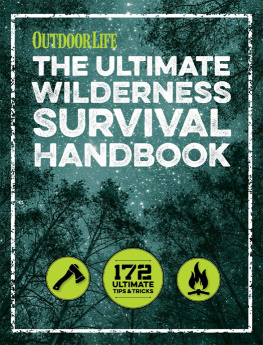
FALCON GUIDES
An imprint of The Rowman & Littlefield Publishing Group, Inc.
4501 Forbes Blvd., Ste. 200
Lanham, MD 20706
Falcon and FalconGuides are registered trademarks and Make Adventure Your Story is a trademark of The Rowman & Littlefield Publishing Group, Inc.
Distributed by NATIONAL BOOK NETWORK
Copyright 2018 BACKPACKER magazine, a division of Active Interest Media
All illustrations by Robert Prince
All rights reserved. No part of this book may be reproduced in any form or by any electronic or mechanical means, including information storage and retrieval systems, without written permission from the publisher, except by a reviewer who may quote passages in a review.
British Library Cataloguing in Publication Information available
Library of Congress Cataloging-in-Publication Data on file.
ISBN 978-1-4930-3056-9
ISBN 978-1-4930-3057-6 (e-book)
 The paper used in this publication meets the minimum requirements of American National Standard for Information SciencesPermanence of Paper for Printed Library Materials, ANSI/NISO Z39.48-1992.
The paper used in this publication meets the minimum requirements of American National Standard for Information SciencesPermanence of Paper for Printed Library Materials, ANSI/NISO Z39.48-1992.
Printed in the United States of America
// ABOUT THE AUTHOR
Ted Alvarez is BACKPACKER magazines Northwest Editor and was a National Magazine Award finalist in 2014. Whether chasing grizzly bears in the North Cascades, fording an icy Alaska river, or drinking his own urine in the desert, he regularly goes to extreme lengths in pursuit of a good storyoften in our national parks. He lives in Seattle, Wash., where he survives on heroic doses of strong coffee.

Credit: istockphoto
But winter brings short days and cold nights. The few human inhabitants pack up for warmer climates, creeks freeze in the negative-degree temps, and 7-foot-high snowdrifts hunch over road corners like sleeping polar bears, sealing the place off.
To most people.
But my family is a different breed, unable to resist the total solitude, spindrift spiraling through tree-filtered sunlight, an endless carpet of powderand the promise of a fire to chase out the chill. Crossing the 7 frozen miles from highway to cabin has become a New Years tradition for my family ten years running. Over that time and those miles, we've learned the value of the Winter Siege, the all-hands approach that turns winter epics into fireside stories.
On one early winter attempt, our tank-tracked ATV bogged down on a particularly heinous snowdrift 2 miles in. We'd left at 10 a.m.plenty of time, we thoughtbut no amount of technique or brute force could dislodge the doomed vehicle from its grave. So we ditched it, strapped on snowshoes, and prepared to haul as many supplies as we could stuff into our packs, prioritizing the beer and wine. Midafternoon sun gave us confidence we had enough light for the 5 miles of untrodden snow ahead.
Breaking trail through deep snow and up steep grades takes a toll, and it didnt take long for my late-50-something parents' pace to slacken. Then my mom caught a snowshoe and fell, twisting a knee already weakened by old ski injuries. As that happened, the sun slipped behind Blanca Peak for good, ushering in deep purples and cold winds. The change from afternoon hike to evening epic was fast: We had 2 miles to go, it was dark, and my mom could only hobble a few feet per minute before stopping to wince and rest.
We inched across crusted slabs while the wind raked us raw. Jeff, my twenty-three-year-old brother, began to shiver and couldnt feel his feet; he'd only brought lightweight cabin layers. With the rules that governed my familys usual interactions blown away in the breeze, three headstrong personalities turned to methe backpackerto unite them. I quickly triaged their fatigue and warmth and turned four individuals into a team. First, I dispatched my brother to run to the cabin to start the fire I knew we'd need.
My mom, dad, and I pushed on until my dads muttering turned toward delirium. He wanted to stay with the group, but I knew by sticking around he'd become a liability so I gave him a job, too: push ahead and widen the track for me and Mom.
As building a snow shelter became a real consideration, I thought about digging a snow trench, but I decided our limited energy was best spent on getting to the fully stocked cabin. Meanwhile, my moms pace had slowed to about 200 yards an hour. Could I rig my avalanche shovel to pull her? Nope. Could I carry her? Deep breath. In 50- to 100-yard stretches, I shuttled the packs ahead and then ran back and carried my mom the same distance. I strained to hold onto her legs through thick gloves, shuffling along the path broken by the others.
I pretended like it was easy as I grunted out involved questions to distract her from the pain. But she distracted me, too, by telling jokes and old stories and marveling at how quiet and special snow-cloaked woods could be in the dead of night. A survival epic was going on, but she either didnt notice or knew basking in the fear wouldnt make a difference anyway. Her chatter kept me going. I repeated the haul-packs-then-haul-mom process until we finally saw a glow through the trees. The cabin. It was 11 p.m.
Inside, Jeff and my dad huddled by the roaring stove, telling tales of hallucinations, wrong turns, swooping owls. I collapsed to the carpet. My refreshed mom had the reserves to keep the fire going and spirits high. Soon, we were thawed and self-medicating with a Malbec slushy. But only because of our teamwork in getting to shelter: brothers speed to the fire, Dads dogged trailblazing, my donkey endurance, Moms unflappable good humor. It all got us pulling in the same direction, ensuring that this is a story we get to keep telling around the winter fire every New Years Eve.
// GIMME SHELTER: BUILDING WILDERNESS SHELTERS
Shelter is the often the thin margin keeping you and death distant acquaintances in the wild. Its the first line of defense, the place you build your life-giving fire, the temporary home where you shore up the mental strength you'll need to conquer any ordeal. If you're losing daylight and dont have a tent, its easy for fear to descend with the temperature and the light. Dont panic: These tested shelter-making techniques will help you survive the night.
Basic: Clothing
It may not be the most obvious when thinking of shelter, but your primary shelter is clothing, so play it safe on excursions from camp and take a jacket and hat. On every trip, pack a synthetic or wool next-to-skin layer, an insulating middle layer, and a waterproof exterior shell jacket.


Good: Fashion a Bed of Leaves
You lose heat to the ground and the air, so you want insulation both above and below. Look for piles of dry foliage, needles, and moss at the base of a tree, and scoop out a trough for your body, or make a heap the size of a single-bed mattress. Collect a stack of cover-up material nearby. Gather three to five times what you think you'll need; the nest will compress, and adding significant warmth requires about two feet of insulation both above and below your body. Lie in your pile, and cover up with your collected debris.
Next page









 The paper used in this publication meets the minimum requirements of American National Standard for Information SciencesPermanence of Paper for Printed Library Materials, ANSI/NISO Z39.48-1992.
The paper used in this publication meets the minimum requirements of American National Standard for Information SciencesPermanence of Paper for Printed Library Materials, ANSI/NISO Z39.48-1992.

